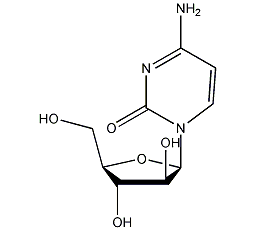
Structural formula
| Business number | 03XC |
|---|---|
| Molecular formula | C9H13N3O5 |
| Molecular weight | 243.22 |
| label |
sponge cytosine, Cytosine-β-D-arabinofuranoside, Cytosine arabinoside, 1-β-D-arabinofuranosyl-4-amino-2(1H)-pyrimidinone, arabinocytosine, Cytarabine, 4-Amino-1-β-D-arabinofuranosyl-2(1H)-pyrimidinone, Arabinocytidine, Ara-C, Cytosine β-D-Arabinofuranoside |
Numbering system
CAS number:147-94-4
MDL number:MFCD00066487
EINECS number:205-705-9
RTECS number:HA5425000
BRN number:None
PubChem number:24892435
Physical property data
1. Properties: white or off-white crystalline powder
2. Melting point (℃): 214
3. Density: 1.89g/cm3
4. Solubility: soluble in water.
Toxicological data
1. Reproductive toxicity: rat abdominal TDLo: 100 mg/kg; rat abdominal TDLo: 20 mg/kg
Ecological data
Other harmful effects: This substance may be harmful to the environment, and special attention should be paid to water bodies.
Molecular structure data
1. Molar refractive index: 52.64
2. Molar volume (cm3/mol): 128.4
3. Isotonic specific volume (90.2K ): 395.1
4. Surface tension (dyne/cm): 89.5
5. Polarizability (10-24cm3): 20.86
Compute chemical data
1. Reference value for hydrophobic parameter calculation (XlogP): None
2. Number of hydrogen bond donors: 4
3. Number of hydrogen bond acceptors: 5
4. Number of rotatable chemical bonds: 2
5. Number of tautomers: 3
6. Topological molecule polar surface area 129
7. Number of heavy atoms: 17
8. Surface charge: 0
9. Complexity: 383
10. Number of isotope atoms: 0
11. Determine the number of atomic stereocenters: 4
12. Uncertain number of atomic stereocenters: 0
13. Determine the number of chemical bond stereocenters: 0
14. Number of uncertain chemical bond stereocenters: 0
15. Number of covalent bond units: 1
Properties and stability
Stable under normal temperature and pressure.
Storage method
Save at 2-8ºC.
Synthesis method
After hydrolysis of 5-cytosine nucleotide, cytosine nucleoside is obtained, which is then chlorinated, epoxidized and hydrolyzed in ammonia water, and finally formed into a salt.
Purpose
Anti-neoplastic drugs, used for acute myelitisCellular leukemia and acute lymphoblastic leukemia, etc. Has antiviral effects.

 微信扫一扫打赏
微信扫一扫打赏

